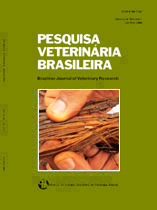 |
|
|
|
Year 2013 - Volume 33, Number 6
|

|
Serial superficial digital flexor tendon biopsies for diagnosing and monitoring collagenase-induced tendonitis in horses, 33(6):710-718
|
ABSTRACT.- Lacerda Neto J.C., Freitas J.M.R., Poggiani F.M., Dias D.P.M., Gravena K., Bernardi N.S., Ribeiro G. & Palmeira-Borges V. 2013. Serial superficial digital flexor tendon biopsies for diagnosing and monitoring collagenase-induced tendonitis in horses. Pesquisa Veterinária Brasileira 33(6):710-718. Departamento de Clínica e Cirurgia Veterinária, Faculdade de Ciências Agrárias e Veterinárias, Universidade Estadual Paulista, Via de Acesso Prof. Paulo Donato Castellane s/n, Jaboticabal, SP 14884-900, Brazil. E-mail: jlacerda@fcav.unesp.br
The purpose of this investigation was to demonstrate the feasibility of a biopsy technique by performing serial evaluations of tissue samples of the forelimb superficial digital flexor tendon (SDFT) in healthy horses and in horses subjected to superficial digital flexor tendonitis induction. Eight adult horses were evaluated in two different phases (P), control (P1) and tendonitis-induced (P2). At P1, the horses were subjected to five SDFT biopsies of the left forelimb, with 24 hours (h) of interval. Clinical and ultrasonographic (US) examinations were performed immediately before the tendonitis induction, 24 and 48 h after the procedure. The biopsied tendon tissues were analyzed through histology. P2 evaluations were carried out three months later, when the same horses were subjected to tendonitis induction by injection of bacterial collagenase into the right forelimb SDFT. P2 clinical and US evaluations, and SDFT biopsies were performed before, and after injury induction at the following time intervals: after 24, 48, 72 and 96 h, and after 15, 30, 60, 90, 120 and 150 days. The biopsy technique has proven to be easy and quick to perform and yielded good tendon samples for histological evaluation. At P1 the horses did not show signs of localised inflammation, pain or lameness, neither SDFT US alterations after biopsies, showing that the biopsy procedure per se did not risk tendon integrity. Therefore, this procedure is feasible for routine tendon histological evaluations. The P2 findings demonstrate a relation between the US and histology evaluations concerning induced tendonitis evolution. However, the clinical signs of tendonitis poorly reflected the microscopic tissue condition, indicating that clinical presentation is not a reliable parameter for monitoring injury development. The presented method of biopsying SDFT tissue in horses enables the serial collection of material for histological analysis causing no clinical signs and tendon damage seen by US images. Therefore, this technique allows tendonitis to be monitored and can be considered an excellent tool in protocols for evaluating SDFT injury. |
| |
|
|
| |
|
 |